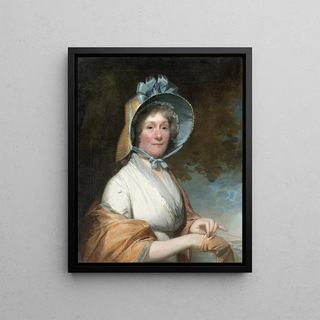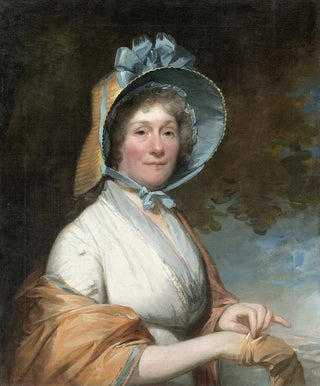Art print | Henrietta Marchant Liston Mme Robert Liston - Gilbert Stuart


View from behind

Frame (optional)
In the captivating world of early 19th-century American painting, the artwork "Henrietta Marchant Liston Mme Robert Liston" by Gilbert Stuart stands out for its refinement and psychological depth. This piece, emblematic of portrait art, captures not only the beauty of its subject but also the essence of an era marked by social and cultural transformations. Through this portrait, Stuart invites us to delve into the intimacy of a woman whose gaze seems to tell untold stories, while reflecting the values and aspirations of a society in full change.
Style and uniqueness of the work
Gilbert Stuart's style, renowned for its ability to blend realism and idealization, is particularly evident here. The portrait of Henrietta Marchant Liston is characterized by meticulous attention to detail, whether in the depiction of her luxurious fabrics or in the delicacy of her features. Every brushstroke appears carefully considered to convey a sense of life and authenticity. The composition, balanced and harmonious, highlights the figure of the woman while subtly integrating elements of her environment. This stylistic choice demonstrates undeniable technical mastery and artistic sensitivity, making this work a true masterpiece. Moreover, light plays a crucial role, illuminating Mme Liston's face and creating a striking contrast with the background, thus adding an almost theatrical dimension to the scene.
The artist and his influence
Gilbert Stuart, born in 1755, is often regarded as one of the most influential portraitists of his time. His career, spanning several decades, was marked by encounters with historical figures such as George Washington, for whom he created several iconic portraits. Stuart established himself through his distinctive style, combining striking realism with a deep psychological approach. His work not only shaped American portraiture but also inspired many artists who followed in his footsteps. By painting members of the social and political elite, he contributed to defining the visual identity of a nation in the process of building. The representation of Henrietta Marchant Liston, a woman of

Matte finish

View from behind

Frame (optional)
In the captivating world of early 19th-century American painting, the artwork "Henrietta Marchant Liston Mme Robert Liston" by Gilbert Stuart stands out for its refinement and psychological depth. This piece, emblematic of portrait art, captures not only the beauty of its subject but also the essence of an era marked by social and cultural transformations. Through this portrait, Stuart invites us to delve into the intimacy of a woman whose gaze seems to tell untold stories, while reflecting the values and aspirations of a society in full change.
Style and uniqueness of the work
Gilbert Stuart's style, renowned for its ability to blend realism and idealization, is particularly evident here. The portrait of Henrietta Marchant Liston is characterized by meticulous attention to detail, whether in the depiction of her luxurious fabrics or in the delicacy of her features. Every brushstroke appears carefully considered to convey a sense of life and authenticity. The composition, balanced and harmonious, highlights the figure of the woman while subtly integrating elements of her environment. This stylistic choice demonstrates undeniable technical mastery and artistic sensitivity, making this work a true masterpiece. Moreover, light plays a crucial role, illuminating Mme Liston's face and creating a striking contrast with the background, thus adding an almost theatrical dimension to the scene.
The artist and his influence
Gilbert Stuart, born in 1755, is often regarded as one of the most influential portraitists of his time. His career, spanning several decades, was marked by encounters with historical figures such as George Washington, for whom he created several iconic portraits. Stuart established himself through his distinctive style, combining striking realism with a deep psychological approach. His work not only shaped American portraiture but also inspired many artists who followed in his footsteps. By painting members of the social and political elite, he contributed to defining the visual identity of a nation in the process of building. The representation of Henrietta Marchant Liston, a woman of






